Abstract
The urokinase-type plasminogen activator receptor (uPAR) is a key molecule in the regulation of cell-surface plasminogen activation and, as such, plays an important role in many normal as well as pathological processes. We applied a cDNA probe from the corresponding gene (PLAUR) in a location analysis using a panel of human/rodent cell hybrids and in a multipoint linkage analysis of 40 CEPH families. These two independent studies both found PLAUR to be located on chromosome 19. The cell hybrid study suggested that PLAUR is located at chromosome 19q13-qter, and the multipoint analysis indicated that PLAUR is located at chromosome 19q13.1-q13.2 and surrounded by DNA markers in the following way (with distances given in recombination fractions): D19S27-.11-CYP2A-.06-PLAUR-.03-D19S8-.04-APOC 2-.24-PRKCG. Further, a ligand-binding study performed on cell hybrids verified the species specificity of the uPAR and confirmed the chromosome assignment.
Full text
PDF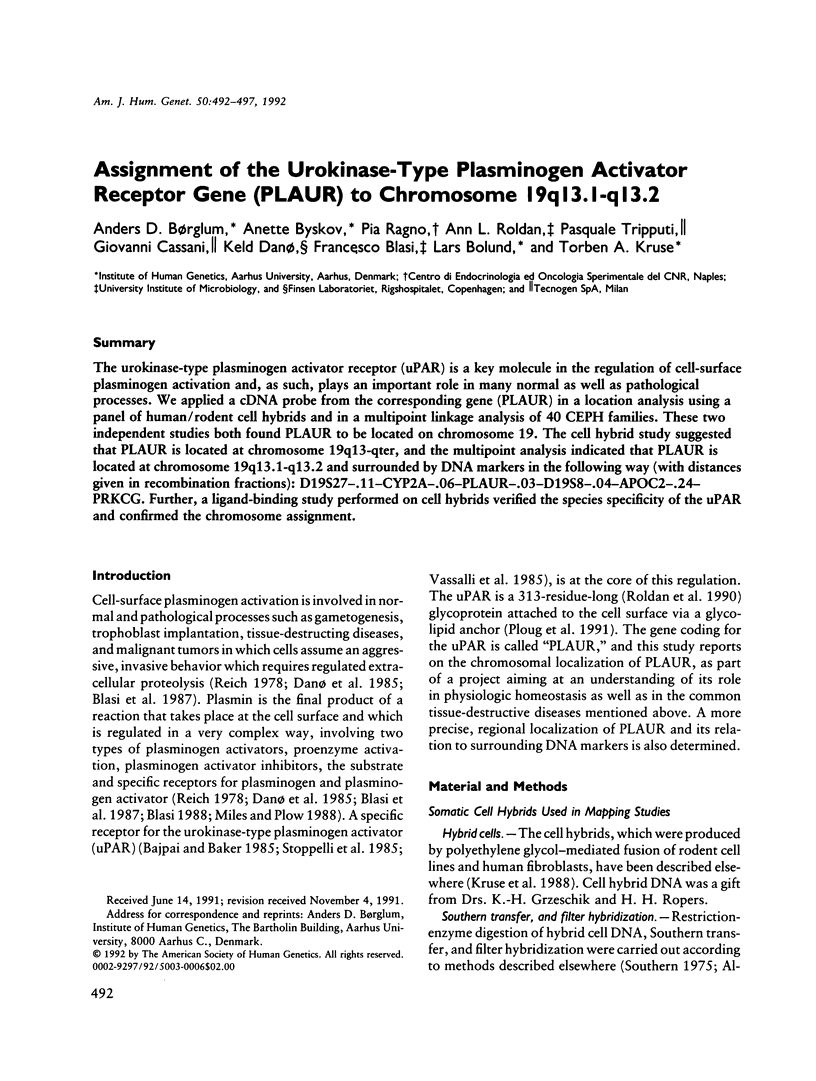
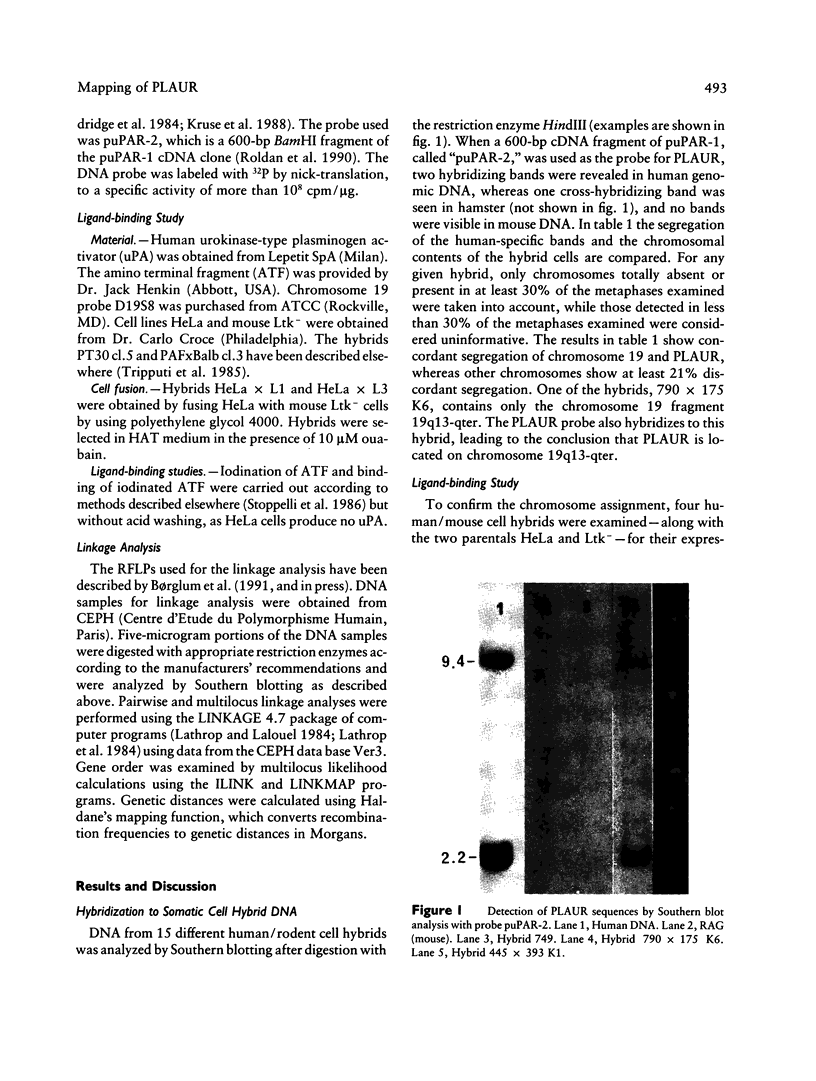
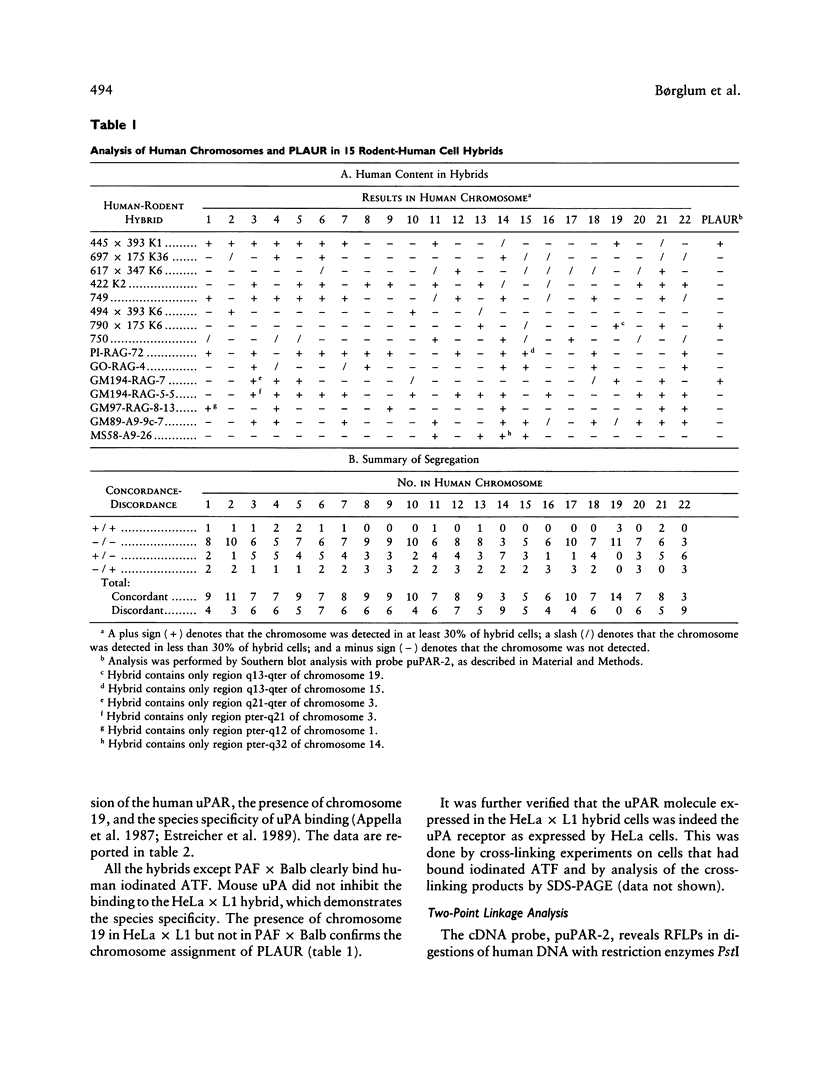
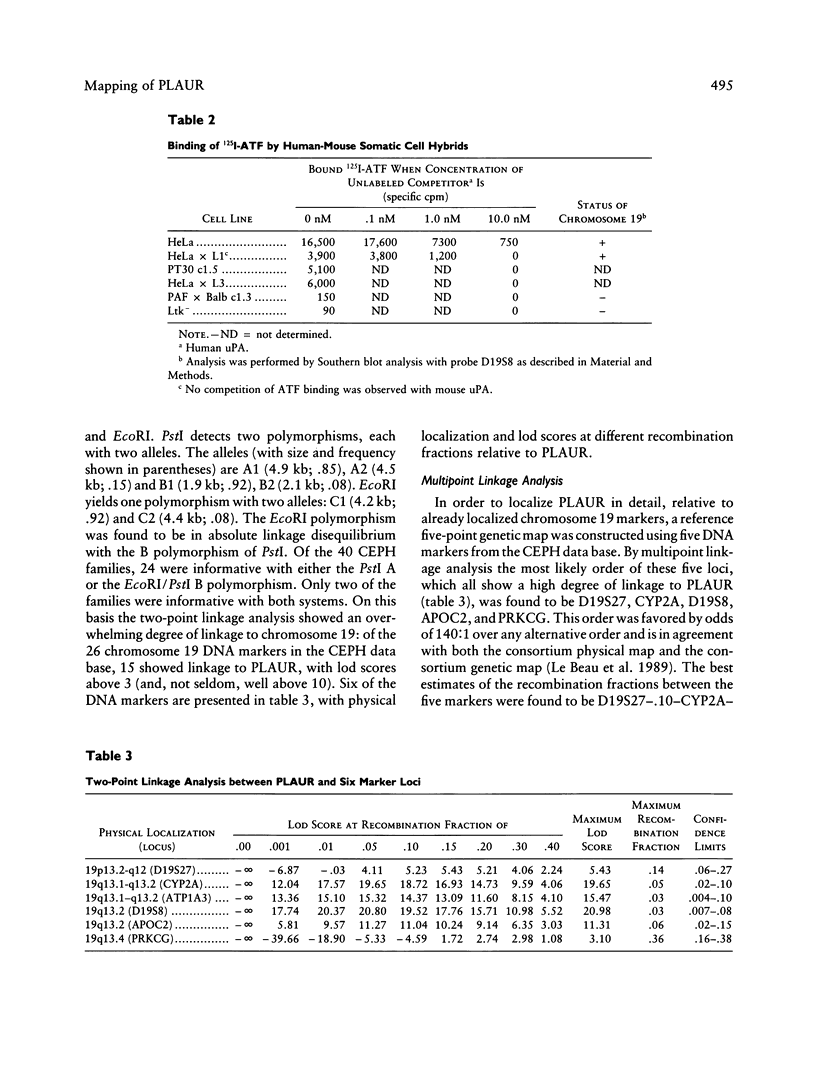
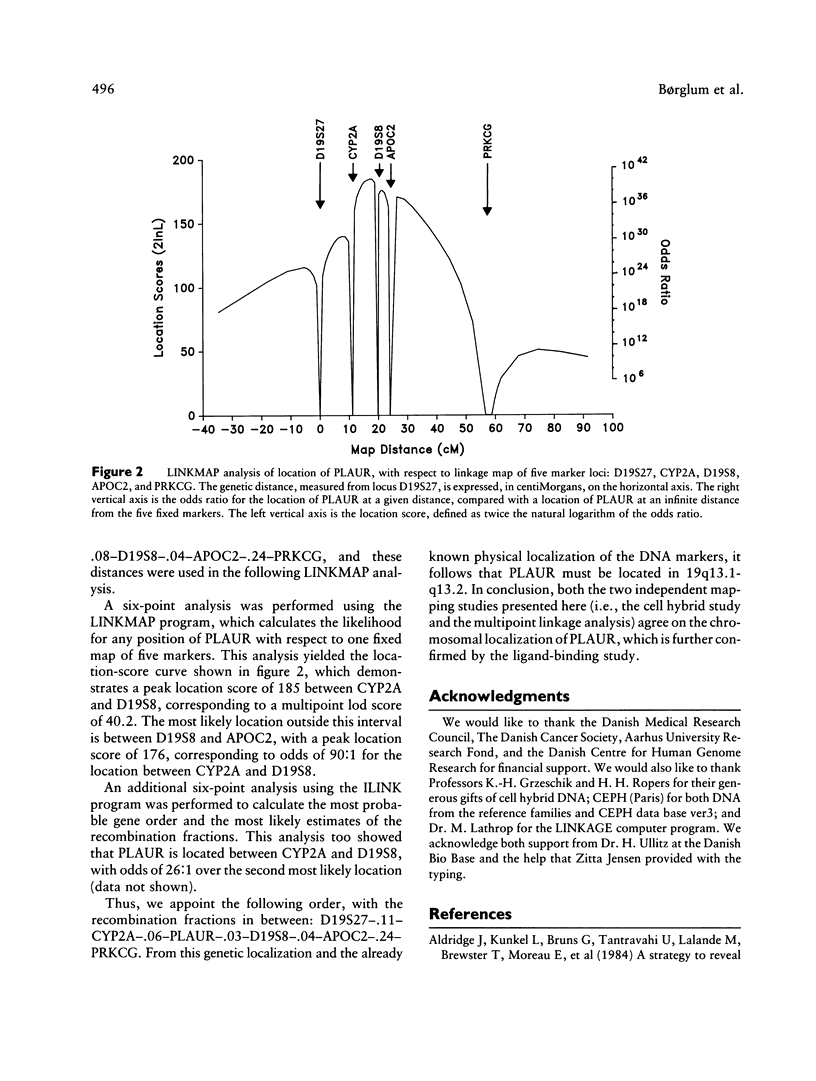
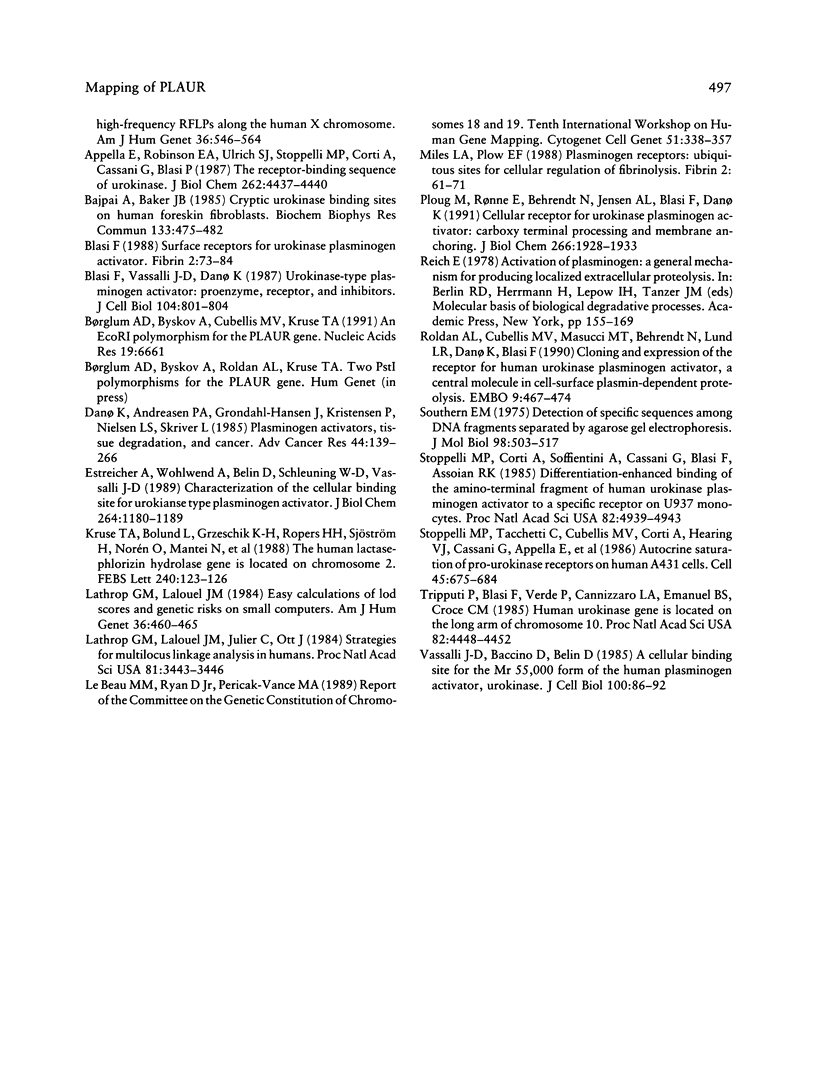
Images in this article
Selected References
These references are in PubMed. This may not be the complete list of references from this article.
- Appella E., Robinson E. A., Ullrich S. J., Stoppelli M. P., Corti A., Cassani G., Blasi F. The receptor-binding sequence of urokinase. A biological function for the growth-factor module of proteases. J Biol Chem. 1987 Apr 5;262(10):4437–4440. [PubMed] [Google Scholar]
- Bajpai A., Baker J. B. Cryptic urokinase binding sites on human foreskin fibroblasts. Biochem Biophys Res Commun. 1985 Dec 17;133(2):475–482. doi: 10.1016/0006-291x(85)90931-3. [DOI] [PubMed] [Google Scholar]
- Blasi F., Vassalli J. D., Danø K. Urokinase-type plasminogen activator: proenzyme, receptor, and inhibitors. J Cell Biol. 1987 Apr;104(4):801–804. doi: 10.1083/jcb.104.4.801. [DOI] [PMC free article] [PubMed] [Google Scholar]
- Børglum A. D., Byskov A., Cubellis M. V., Kruse T. A. An EcoRI polymorphism for the PLAUR gene. Nucleic Acids Res. 1991 Dec 11;19(23):6661–6661. doi: 10.1093/nar/19.23.6661-a. [DOI] [PMC free article] [PubMed] [Google Scholar]
- Danø K., Andreasen P. A., Grøndahl-Hansen J., Kristensen P., Nielsen L. S., Skriver L. Plasminogen activators, tissue degradation, and cancer. Adv Cancer Res. 1985;44:139–266. doi: 10.1016/s0065-230x(08)60028-7. [DOI] [PubMed] [Google Scholar]
- Estreicher A., Wohlwend A., Belin D., Schleuning W. D., Vassalli J. D. Characterization of the cellular binding site for the urokinase-type plasminogen activator. J Biol Chem. 1989 Jan 15;264(2):1180–1189. [PubMed] [Google Scholar]
- Kruse T. A., Bolund L., Grzeschik K. H., Ropers H. H., Sjöström H., Norén O., Mantei N., Semenza G. The human lactase-phlorizin hydrolase gene is located on chromosome 2. FEBS Lett. 1988 Nov 21;240(1-2):123–126. doi: 10.1016/0014-5793(88)80352-1. [DOI] [PubMed] [Google Scholar]
- Lathrop G. M., Lalouel J. M. Easy calculations of lod scores and genetic risks on small computers. Am J Hum Genet. 1984 Mar;36(2):460–465. [PMC free article] [PubMed] [Google Scholar]
- Lathrop G. M., Lalouel J. M., Julier C., Ott J. Strategies for multilocus linkage analysis in humans. Proc Natl Acad Sci U S A. 1984 Jun;81(11):3443–3446. doi: 10.1073/pnas.81.11.3443. [DOI] [PMC free article] [PubMed] [Google Scholar]
- Le Beau M. M., Ryan D., Jr, Pericak-Vance M. A. Report of the committee on the genetic constitution of chromosomes 18 and 19. Cytogenet Cell Genet. 1989;51(1-4):338–357. doi: 10.1159/000132798. [DOI] [PubMed] [Google Scholar]
- Ploug M., Rønne E., Behrendt N., Jensen A. L., Blasi F., Danø K. Cellular receptor for urokinase plasminogen activator. Carboxyl-terminal processing and membrane anchoring by glycosyl-phosphatidylinositol. J Biol Chem. 1991 Jan 25;266(3):1926–1933. [PubMed] [Google Scholar]
- Roldan A. L., Cubellis M. V., Masucci M. T., Behrendt N., Lund L. R., Danø K., Appella E., Blasi F. Cloning and expression of the receptor for human urokinase plasminogen activator, a central molecule in cell surface, plasmin dependent proteolysis. EMBO J. 1990 Feb;9(2):467–474. doi: 10.1002/j.1460-2075.1990.tb08132.x. [DOI] [PMC free article] [PubMed] [Google Scholar]
- Southern E. M. Detection of specific sequences among DNA fragments separated by gel electrophoresis. J Mol Biol. 1975 Nov 5;98(3):503–517. doi: 10.1016/s0022-2836(75)80083-0. [DOI] [PubMed] [Google Scholar]
- Stoppelli M. P., Corti A., Soffientini A., Cassani G., Blasi F., Assoian R. K. Differentiation-enhanced binding of the amino-terminal fragment of human urokinase plasminogen activator to a specific receptor on U937 monocytes. Proc Natl Acad Sci U S A. 1985 Aug;82(15):4939–4943. doi: 10.1073/pnas.82.15.4939. [DOI] [PMC free article] [PubMed] [Google Scholar]
- Stoppelli M. P., Tacchetti C., Cubellis M. V., Corti A., Hearing V. J., Cassani G., Appella E., Blasi F. Autocrine saturation of pro-urokinase receptors on human A431 cells. Cell. 1986 Jun 6;45(5):675–684. doi: 10.1016/0092-8674(86)90782-8. [DOI] [PubMed] [Google Scholar]
- Tripputi P., Blasi F., Verde P., Cannizzaro L. A., Emanuel B. S., Croce C. M. Human urokinase gene is located on the long arm of chromosome 10. Proc Natl Acad Sci U S A. 1985 Jul;82(13):4448–4452. doi: 10.1073/pnas.82.13.4448. [DOI] [PMC free article] [PubMed] [Google Scholar]
- Vassalli J. D., Baccino D., Belin D. A cellular binding site for the Mr 55,000 form of the human plasminogen activator, urokinase. J Cell Biol. 1985 Jan;100(1):86–92. doi: 10.1083/jcb.100.1.86. [DOI] [PMC free article] [PubMed] [Google Scholar]



